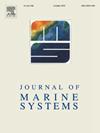Climate-driven warming, deoxygenation, and desertification in large marine ecosystems
IF 2.5
3区 地球科学
Q2 GEOSCIENCES, MULTIDISCIPLINARY
引用次数: 0
Abstract
This study explores Large Marine Ecosystems (LME) impacts caused by climate-induced changes in sea surface temperature (SST), surface dissolved oxygen concentrations (O2), and surface phytoplankton concentrations (CHL). It spans pre-industrial (1850–1900) to future (2015–2099) epochs under Shared Socioeconomic Pathways (SSPs) medium (SSP-2.45) and high (SSP-5.85) CO2 emission scenarios. Across the 66 LMEs, we observed consistent warming, deoxygenation, and desertification, with more pronounced changes in SSP-5.85. SST trends (°C/decade) varied from 0.04 to 0.29 (SSP-2.45) and 0.12 to 0.63 (SSP-5.85), resulting in net increases from >3 °C (SSP-2.45) to >4.5 °C (SSP-5.85). O2 exhibited trends (μmol/kg/decade) of −0.04 to −1.97 (SSP-2.45), with substantial declines in SSP-5.85 (−0.86 to −3.93), and significant net decreases (μmol/kg) of >−18 (SSP-2.45) and >−25 (SSP-5.85). CHL showed significant decreases (kg/m3) up to −0.31 (SSP-2.45) and −0.36 (SSP-5.85), with negative trends (kg/m3/decade) up to −0.0097 (SSP-2.45) and −0.0159 (SSP-5.85), except the Black Sea and Antarctica which exhibited positive trends. Climate indices reveal that LMEs experiencing the least impacts across all indicators occur in the East Siberian Sea, Faroe Plateau, Central Arctic, and Gulf of Mexico, in both scenarios. However, under the SSP-2.45 scenario, additional the Laptev Sea, Insular Pacific-Hawaiian also experienced lower impacts. In SSP-5.85, reduced impacts are observed in the South Brazil Shelf, East Brazil Shelf, Agulhas Current, West Central Australian Shelf, and Canadian High Arctic-North Greenland. Conversely, the most impacted LMEs, including the Barents Sea, Norwegian Sea, Oyashio Current, West Bering Sea, and the Aleutian Islands are affected in both scenarios. Additionally, the Pacific Central-American Coastal region, the Gulf of Alaska, Benguela Current, and the Sea of Japan are affected in the SSP-2.45 scenario. Only the Scotian Shelf experienced high impacts in SSP-5.85. Antarctica exhibited low impacts in both scenarios but substantial increases in SST, O2, and CHL.
大型海洋生态系统中气候驱动的变暖、脱氧和荒漠化
本研究探讨了气候引起的海表温度(SST)、表层溶解氧浓度(O2)和表层浮游植物浓度(CHL)变化对大型海洋生态系统(LME)的影响。在共享社会经济路径(ssp)中(SSP-2.45)和高(SSP-5.85)二氧化碳排放情景下,它跨越了工业化前(1850-1900)到未来(2015-2099)时代。在66个LMEs中,我们观察到一致的变暖、脱氧和沙漠化,其中SSP-5.85的变化更为明显。海温趋势(°C/ 10年)在0.04 ~ 0.29 (SSP-2.45)和0.12 ~ 0.63 (SSP-5.85)之间变化,导致净增温从3°C (SSP-2.45)增加到4.5°C (SSP-5.85)。O2的变化趋势(μmol/kg/decade)为−0.04 ~−1.97 (SSP-2.45), SSP-5.85显著下降(−0.86 ~−3.93),而ssp - 18 (SSP-2.45)和ssp - 25 (SSP-5.85)显著净下降(μmol/kg)。除黑海和南极洲呈正趋势外,CHL呈负趋势(kg/m3/ 10年),分别为- 0.31 (SSP-2.45)和- 0.36 (SSP-5.85),负趋势(kg/m3/ 10年)为- 0.0097 (SSP-2.45)和- 0.0159 (SSP-5.85)。气候指数显示,在两种情景下,东西伯利亚海、法罗高原、北极中部和墨西哥湾的LMEs受所有指标影响最小。然而,在SSP-2.45情景下,拉普捷夫海、岛屿太平洋-夏威夷也受到了较小的影响。在SSP-5.85中,在南巴西大陆架、东巴西大陆架、阿古拉斯海流、西澳大利亚大陆架和加拿大北极-北格陵兰高地观察到的影响减少。相反,受影响最大的LMEs,包括巴伦支海、挪威海、大潮流、西白令海和阿留申群岛,在两种情况下都受到影响。此外,太平洋中美洲沿海地区、阿拉斯加湾、本格拉海流和日本海也受到SSP-2.45情景的影响。只有苏格兰大陆架在SSP-5.85中受到了高影响。南极洲在两种情景下都表现出较低的影响,但海温、O2和CHL大幅增加。
本文章由计算机程序翻译,如有差异,请以英文原文为准。
求助全文
约1分钟内获得全文
求助全文
来源期刊

Journal of Marine Systems
地学-地球科学综合
CiteScore
6.20
自引率
3.60%
发文量
81
审稿时长
6 months
期刊介绍:
The Journal of Marine Systems provides a medium for interdisciplinary exchange between physical, chemical and biological oceanographers and marine geologists. The journal welcomes original research papers and review articles. Preference will be given to interdisciplinary approaches to marine systems.
 求助内容:
求助内容: 应助结果提醒方式:
应助结果提醒方式:


